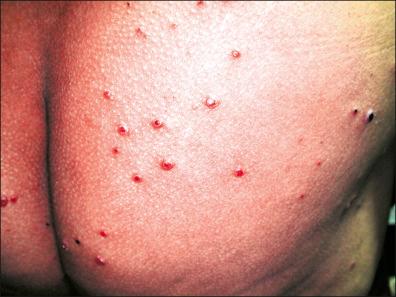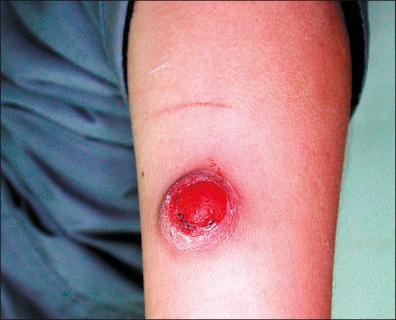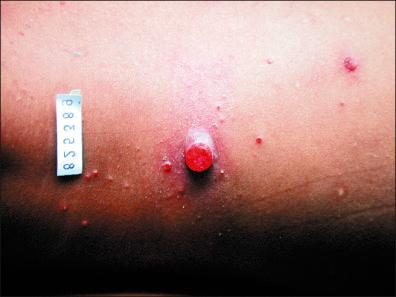Physical Address
304 North Cardinal St.
Dorchester Center, MA 02124
Bartonella bacilliformis was described more than 100 years ago as the cause of Carrión disease (CD) but it remained a medical curiosity until the description of bacillary angiomatosis (BA) in the late 1980s. The genus Bartonella has received great attention since, and research on the matter has flourished. This is a group of bacteria that are selective mammalian pathogens requiring specific vectors to be transmitted. Some bacteria in this group are capable of stimulating endothelial cells in vitro and inducing angiogenesis in vivo; in Carrión disease the mechanisms include stimulation of production of vascular endothelial growth factor (VEGF), its receptors VEGFR-1 and VEGFR-2, and angiopoetin-2. Except for VEGF, which is produced by epidermal cells, all other factors are produced by the proliferating endothelium, revealing a close interaction among those two cell populations.
B. bacilliformis is known to induce immunosuppression in cases of CD by lowering the number of T-helper lymphocytes. Both B. bacilliformis and B. henselae are capable of entering red blood cells by the action of specific proteins called deformins, causing hemolytic disease in human and cats. Different species of Bartonella have different mammalian reservoirs: B. bacilliformis and B. quintana have a predilection for humans, whereas B. henselae and B. clarridgeae seems to prefer felines. The preferences of B. bacilliformis for humans and B. henselae for cats may be explained on the basis of red-blood-cell receptor differences as well as the characteristic motility of B. bacilliformis .
The first condition linked to this bacterium was Carrión disease. Caused by B. bacilliformis , it has two remarkable different clinical phases: one of systemic involvement characterized by fever, septicemia, and anemia, also known as Oroya fever (OF), and later an eruptive phase of angiomatous papular and nodular skin lesions, known as verruga peruana (VP). Although the reported cases were restricted to small endemic areas of Peru and Ecuador, the condition was briefly mentioned in major textbooks of medicine.
The history of VP goes back hundreds of years. Pottery from pre-Inca cultures such as the Huaylas shows human faces with papular lesions that could be interpreted as those of the eruptive phase of VP.
In colonial times (sixteenth and seventeenth centuries) a chronicle described an epidemic outbreak of bleeding, oozing, and exophytic lesions affecting the face and body of Spanish troops belonging to Francisco Pizarro (the conqueror of Peru), in the area of Coaque, Ecuador.
By the 1870s, nothing was known about the relation between the eruptive angiomatous lesions known as VP and a systemic disease, with extremely high mortality, affecting a group of workers on the trans-Andean railroad in the central Sierra. The disease was named Oroya fever, after the location where most cases were detected.
By 1872 the possibility that OF and VP were parts of the same unique process was raised. That current of opinion led to the experiments conducted by Daniel Alcides Carrión.
Carrión was a medical student, born in 1857, who developed a great interest in VP and OF. On 17 August 1885, in a self-promoted experiment that took his scientific curiosity to an extreme, and lacking complete awareness of the risk involved, he was inoculated with material from verruga. He was expecting to develop just the anemia, not the febrile illness. Unfortunately, the disease went on to its most severe state: first fever, then severe anemia, to finally provoke his death on 5 October 1885, at the age of 28. Carrión's experiment, at the expense of his own life, proved that both clinical manifestations were truly part of a unique process, as well as establishing that the disease could be transmissible by the infectious material.
In 1909 Alberto Barton, a Peruvian doctor working at the Guadalupe Hospital of Callao, discovered the presence of what he called “X bodies” inside the red blood cells of patients affected by OF; this is considered the first description of the etiologic agent and hereafter the bacteria was called Bartonella .
Bartonella became a medical curiosity, although interesting research continued to be done on a minor scale in Peru, the USA, UK, and France.
Before the 1980s the etiology of cat-scratch disease (CSD) was unknown. After an original publication implicating a new bacterial agent, Afipia felis , in the etiology of CSD, later reports failed to confirmed that observation; however, there was agreement on the bacterial origin of the disease, and also its capability of being stained with silver techniques. Those were the arguments used by LeBoit and colleagues to establish the link between CSD and a disease described by Stoler in New York, in 1984, affecting AIDS patients. Once the microorganism causing such disease, by then denominated bacillary angiomatosis, was isolated, it was initially described as being part of a new genus named Rochalima ; further genetic analysis allowed scientists to unify concepts and reclassify it as a member of the already existent Bartonella genus.
The Bartonella family is best classified as belonging to the α 2 subgroup of bacteria, in the Protobacteriae class, that also includes closely related microorganisms such as Brucella, Agrobacterium, Afipia, and Rickettsia .
The Bartonella spp. are mammalian intracellular pathogens that require a vector for their transmission. The family had only one element, Bartonella bacilliformis , up until 1993. By then, DNA–DNA hybridization data and comparisons of existing 16S rRNA gene sequences gave sufficient evidence for merging the Rochalima genus with Bartonella . Similar studies led to the incorporation of Grahamella species into the same genus in 1995.
The prototype bacterium is B. bacilliformis , and currently the family includes 31 validated species ( http://www.bacterio.net/index.html ), some of which are known to cause disease in humans: B. bacilliformis, B. quintana, B. henselae, B. elizabethae, B. clarridgeiae, B. vinsonii, B. rochalimae , and B. khoelerae ( Table 25-1 ). Multilocus sequence typing puts B. clarridgeiae and B. rochalimae as the species with the closest relation to B. bacilliformis , followed by B. henselae and B Quintana . Afipia felis , a putative agent causing CSD, is in fact closer to Rickettsia than to Bartonella . The close relation with other bacteria such as Agrobacterium tumefaciens becomes more intriguing if one takes into consideration that this last organism is capable of inducing tissue proliferation in infected plants, similar to that seen in VP and BA.
| Agent | Natural Host | Vector | Disease in the Immunocompetent | Disease in the Immunosuppressed |
|---|---|---|---|---|
| B. bacilliformis | Human | Lutzomyia | Carrión disease | |
| B. quintana | Human | Louse | Trench fever | Bacillary angiomatosis |
| B. henselae | Cat | Flea | Cat-scratch disease | Bacillary angiomatosis |
| B. clarridgeiae | Cat | Flea | Cat-scratch disease | |
| B. elizabethae | Human | Louse | Bacteremia–septicemia |
The members of this family can be described as Gram-negative, oxidase-negative, fastidious, aerobic rods. Although they are intracellular microorganisms in vivo, they are not obligate intracellular pathogens, which is another difference from the Rickettsia family. B. bacilliformis has a unique polar flagellum adapted for motility.
The organisms are difficult to grow. They require blood agar media, and temperature and CO 2 requirements vary depending on the species. Growth is optimal at 37°C, with the exception of B. bacilliformis , which requires lower temperatures of 25–28°C. B. bacilliformis is also unique because it grows better without CO 2 supplements. The primary isolates are obtained after a period of 12–14 days, but this may extend up to 45 days. First subcultures are also difficult, with colony formation taking 10–15 days. Repeated subcultures may take only 3–5 days, but with subsequent variations in morphology.
Oroya fever (hematic phase), verruga peruana (eruptive phase)
Bartonella bacilliformis .
Living or traveling to endemic areas.
Oroya fever: febrile state, anemia, hemolysis.
Verruga peruana: eruptive angiomatous papules and nodules.
Carrión disease is the best current denomination for those clinical features associated with B. bacilliformis . The systemic, febrile disease is named OF, and represents the hematogenous phase. The cutaneous disease of eruptive angiomatous lesions is denominated VP and is considered a self-resolving condition. Both can be seen as a sequence, affecting the same patient, although most cases will develop either OF or VP. It is frequently said that OF is most common and more severe in patients who are foreigners to endemic areas; however, some recent reports tell us that this is not always the case. VP seems to be more common in local inhabitants, especially children.
The disease has been confined for a long time to specific regions of Peru and Ecuador, with only a single epidemic occurring in Colombia in 1939. The endemic areas in Peru are located in the northern Andes, and the disease was always said to follow a very specific range of altitudes, 500–3200 m above sea level. However, in recent years the descriptions of outbreaks in lower regions, in the limit between the Sierra and the Amazon forest, seem to indicate a change in the distribution of vectors, the incorporation of new vectors in the transmission of the disease, and the possibility of migratory workers acting as potential mobile human reservoirs. The main vector is a sand fly, Lutzomya verrucarum , which is also a vector for cutaneous leishmaniasis. The insect is always close to human dwellings and most infections are produced by female biting habits at sunrise and sunset.
B. bacilliformis is transmitted by the Lutzomya bite. Once inoculated, the bacteria will have a tropism for a population of cells that will act as a niche; this population of cells most likely includes endothelial cells as well as lymphocytes and macrophages; after that, the microorganism will go into the blood stream and rapidly invade the red cells (it is the only bacterium known to do so). Through the action of specific proteins called deformins, it induces the invagination of the cell membrane and this is incorporated into the red cell cytoplasm. It may invade up 100% of the red-cell population, inducing hemolysis; after its release, it may be then captured by the reticuloendothelial system. From then on, the microorganism enters a dormant state, to reappear later in the interstice of eruptive VP.
Once an individual has been infected by Bartonella , the infection may follow a subclinical course or evolve into a febrile illness known as OF. The incubation period is 61 days, with a range of 10–210 days. The patient will experience a gradual appearance of fever, malaise, headache, and mild chills; generalized weakness as well as back and extremity pain may follow. Then, the development of severe anemia will dominate the clinical picture. The anemia is produced by hemolysis. This remarkable distinct bacterium can actually be seen in peripheral smears inside erythrocytes. Profound paleness, jaundice, and dyspnea are signs of the ongoing hemolytic process. Hepatosplenomegaly and generalized lymphadenopathy may develop. Changes in mental status, from mild somnolence to coma and seizures, represent progressive central nervous system involvement. Complications seen during this period include severe peripheral edema, non-cardiogenic pulmonary edema, myocarditis, and hemorrhagic pericarditis.
The OF state may last 2–4 weeks. Up to 30% of patients may develop opportunistic infections by Salmonella, Toxoplasma, Plasmodium , and Histoplasma, as well as Staphylococcus septicemia. Untreated OF may have high mortality rates, from 30 to 80%. However, with appropriate antibiotic treatment this rate can be reduced significantly to less than 9%.
A 1998 outbreak outside the endemic area has shown some special features that are worth mentioning. The estimated mortality rates were lower than expected, compared with the classical endemic areas; also many patients with fever, malaise, and serologic evidence of disease did not develop anemia at all. Such a finding raises the possibility of variable degrees of virulence, in relation to different strains of B. bacilliformis . Small surveys in well-known endemic areas have shown serologic evidence of infection in up to 60% of the local population, indicating a larger than expected number of patients developing a subclinical infection and becoming human reservoirs.
The most relevant form of Carrión disease for the dermatologist is the eruptive phase known as VP. This phase is characterized by the progressive appearance of one to several angiomatous lesions. The disease is most commonly seen in children, and can be located anywhere in the body, with a special predilection for the extremities. Mucous membrane involvement has been rarely described, as far as the larynx and the rectum. There are three classical types of lesions: the miliary type ( Fig. 25-1 ), which is a more superficial, reddish papule with a collarette; the nodular type, which is larger, located deeper, and covered by intact epidermis; and the mular type ( Figs. 25-2 and 25-3 ), which is identical to the nodular type but with an angiomatous, eroded surface. Interestingly, some patients in the VP stage will have systemic symptoms, and a few may even have fever, anemia, and positive peripheral blood smears. Lesions of VP are quite similar to the lesions seen in BA, reinforcing the idea of similar bacteria producing similar clinical pictures. For those who have had the opportunity to see cases of both diseases, no clinical difference can be established between the cutaneous lesions of VP and those of BA. Lesions of VP tend to regress spontaneously, although this process may take weeks to months.



Diagnosis of OF is based on clinical findings: fever, headache, arthralgia, and evidence of hemolytic anemia. The most useful laboratory test is a peripheral blood smear, looking for the presence of bacteria parasitizing red blood cells. Additional methods include blood culture (quite difficult in the case of B. bacilliformis ) and serology by enzyme-linked immunosorbent assay (ELISA) or western blot, which have demonstrated high sensitivity and specificity. Unfortunately, they are not readily available in the rural areas where the disease is more commonly seen.
The differential diagnosis for OF will include any febrile processes, such as malaria, typhoid fever, yellow fever, typhus, and brucellosis. A febrile illness very similar to OF has been recently described in Peru as caused by B. rochalimae.
Diagnosis of VP is made on the basis of clinical and histologic findings. Warthin–Starry staining will show bacilli in the stroma of the vascular lesion. The differential diagnosis includes any vascular angiomatous lesions, including pyogenic granuloma, hemangioma, adnexal tumors, Kaposi sarcoma, angiolymphoid hyperplasia with eosinophilia, and, in case of solitary lesions, even Spitz nevus.
Become a Clinical Tree membership for Full access and enjoy Unlimited articles
If you are a member. Log in here